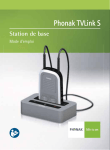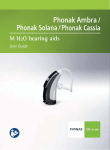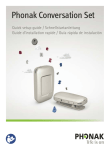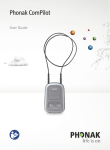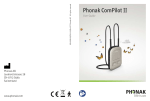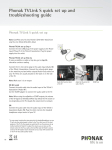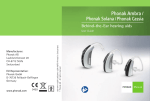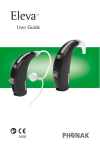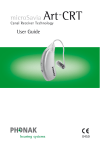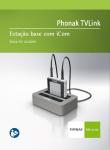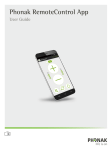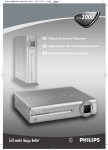Download User Guide TVLink S
Transcript
Basestation User Guide Contents 1. Welcome 5 2. Getting to know your TVLink S 6 3. Getting started 11 Step 1. Setting up the power supply 11 Step 2. Connecting the TVLink S basestation 12 Step 3. Switching on all devices 17 Step 4. Pairing ComPilot and the TVLink S basestation 19 4. Daily usage of the Phonak TVLink S 22 Step 5. Wearing your ComPilot 22 Step 6. Listening to the TV 23 Step 7. Adjusting the volume of the TV signal 25 Step 8. Pause and phone calls during operation 27 Step 9. Switching off your TVLink S basestation and ComPilot 29 Step 10. Charging ComPilot 2 31 5. Troubleshooting 34 5.1 Testing the audio transmission 34 5.2 Questions and answers 36 6. Important information: 39 6.1 Hazard warnings 39 6.2 Information on product safety 40 7. Service and warranty 43 8. Compliance information 44 9. Information and explanation of symbols 47 3 1. Welcome Congratulations on choosing the Phonak TVLink S. It expands the way you hear your world by wirelessly connecting your hearing aids to your TV and other entertainment or communication devices. Please read this user guide carefully to discover how to benefit from all the features of your TVLink S. Please also carefully read the “Important information” section in chapter 6. Phonak – life is on www.phonak.com 5 2. Getting to know your TVLink S The complete Phonak TVLink S system consists of the following elements: (h) Power supply with mini-USB plug and country adapter ComPilot* (i) Audio cable for RCA/Cinch sockets (j) Audio cable for 3.5 mm jack sockets Phonak TVLink S basestation (k) SCART/Peritel adapter (optional) * The TVLink S extension package contains the standalone TVLink S basestation with power supply and all cables. 6 Device description The Phonak TVLink S connects your hearing aids wirelessly to your TV or other audio devices. The system consists of three main elements: Your hearing aids, the ComPilot and the Phonak TVLink S basestation. hearing aid Up to 30 meters (100 ft) Cable ComPilot TVLink S basestation 7 2. Getting to know your TVLink S Phonak ComPilot streamer and remote control 9 : 8 au dio pow er Buttons / Main ( ) 0 Volume +/- ( ) 1 Home ( 2 Connect ( ) 3 ON/OFF switch ( / ) 0 ) Inputs 4 Microphone openings 5 Audio input (3.5 mm jack) 6 FM input (Europlug) 7 Charging input (mini-USB) 3 4 ; < Indicators 8 Audio indicator 9 Power indicator Neckloop : Neckloop sockets ; Neckloop (with antenna) < Neckloop plugs 2 1 5 6 7 8 For detailed information on the ComPilot such as features, light indicator explanations, other input sources, etc., please refer to the ComPilot user guide which is delivered with each ComPilot. The Bluetooth® word mark and logos are registered trademarks owned by Bluetooth SIG, Inc. and any use of such marks by Phonak is under license. Other trademarks and trade names are those of their respective owners. 9 2. Getting to know your TVLink S Phonak TVLink S basestation The TVLink S basestation is connected to your TV (or any other audio source) and wirelessly sends audio signals from your TV to ComPilot within a range of up to 30 meters (100 ft). The TVLink S basestation also serves as a charging cradle for ComPilot when ComPilot is not in use. (f) (g) Buttons (a) ON/OFF button (b) TV signal volume (up) (c) TV signal volume (down) Inputs (d) Power input (mini-USB) (e) Audio input (3.5 mm jack) (f) ComPilot charging slot (c) (a) (b) (g) Status light (d) (e) TVLink S basestation 10 3. Getting started Step 1. Setting up the power supply 1. Select the adapter that corresponds to your country. US EU UK AUS 2. Insert the round corner of the adapter to the round corner of the universal power supply until it is completely inserted. 2. 3. 3. Click the tail of the adapter in to lock it into place. Make sure the adapter is securely locked. To remove the power adapter: a. Pull back the tab on the universal power supply and hold. b. Gently pull the adapter upwards to remove it from receptacle. c. Then start over with step 1 (above). a. b. 11 3. Getting started Step 2. Connecting the TVLink S basestation To connect the power supply: Place the TVLink S basestation next to your TV. Connect the mini-USB plug (d) of the power supply to the Power input (“Power”) of the TVLink S basestation. Plug the power supply into the wall socket (h). TVLink S basestation (h) (d) 12 Use the RCA/Cinch cable (i) to connect the TVLink S basestation to the TV: Connect the stereo (e) plug to the audio input (“Audio IN”) of the TVLink S basestation. Connect the red and white plugs (i) to the matching red and white output sockets on your TV. (i) (e) 13 3. Getting started You can also connect your TVLink S basestation to the headset socket of your TV, using the audio cable: Connect the stereo plug (e) to the audio input of the TVLink S basestation (“Audio IN”). Plug the other end into the headset output socket of your TV. (e) (j) 14 When connecting the TVLink S basestation to the headset socket of your TV you are able to adjust the volume via your TV remote control. Some TVs will switch off their loudspeakers when plugging the jack into the headset socket – the TV will not be audible for other people. In such a case use the Cinch/RCA or SCART output socket as described above. For further information on volume adjustment please refer to step 7 below. The Phonak TVLink S basestation can also be connected to any other audio source such as an MP3 player, PC or home sound system using the stereo plug cable (j). 15 3. Getting started Optionally you may use a SCART adaptor: Plug one end of the audio cable (j) into the TVLink S basestation and the other end into the SCART adaptor. Then plug the SCART adaptor (k) into a free SCART output socket of your TV. (k) (e) (j) 16 Step 3: Switching on all devices To use the TVLink S, all devices must to be switched on. Switch on your TV or other audio source. Make sure your hearing aids are switched on and properly in place. To turn ON your ComPilot, slide the power switch 3 to the ON position as shown in fig. 1. ComPilot io power pow po ow wer we er ON Fig. 1 17 3. Getting started Switch on the TVLink S basestation by a short press of the ON/OFF button (a) as shown in fig. 2. The status light (g) will illuminate green initially and may switch to blue later. TVLink S basestation (a) (g) Fig. 2 If the ComPilot Power indicator 9 blinks red or is not illuminated at all, the ComPilot battery level may be low. In this case please first charge the ComPilot as described in step 10 on page 32. For a more detailed explanation of the ComPilot indicator lights please refer to the ComPilot user guide. 18 Step 4: Pairing ComPilot and the TVLink S basestation If you received the ComPilot and the TVLink S basestation together in the complete TVLink S package, ComPilot is already paired with the TVLink S basestation. You will see two solid blue light indicators, (g) and 8, and may directly proceed to step 5. Before starting to use the TVLink S system, ComPilot and the TVLink S basestation need to be paired. The pairing procedure controls which Bluetooth devices are permitted to communicate with each other. Make sure both devices are switched on as described in step 3 above. You do not need to insert ComPilot into the basestation charging slot (f) during pairing. Pairing needs to be completed only once for each device you wish to use with your ComPilot. 19 3. Getting started 1. Press and hold the ComPilot and button simultaneously for 2 seconds until the Audio indicator 8 starts to rapidly blink blue (fig. 3). Your ComPilot will remain in the pairing mode for two minutes or until the pairing is completed. audi au audio uddi udi dio io Press Fig. 3 20 / 2 sec power 2. If the TVLink S basestation status light (g) is not rapidly blinking blue already, press the ON/OFF button (a) for 5 seconds until the Bluetooth indicator (g) is rapidly blinking blue as shown in fig 4. (a) Press 5 sec Fig. 4 3. Wait until both Bluetooth indicator lights 8, (g) turn solid blue. This can take up to 2 minutes but typically is done within a few seconds. 21 4. Daily usage of the Phonak TVLink S First switch on both devices as described in step 3. Step 5: Wearing your ComPilot Before any phone, music or TV streaming can take place, the ComPilot must be switched ON and worn correctly as shown below: 1. Put the neckloop around your neck (easily done when unplugging one neckloop plug). 2. Make sure both plugs are well connected in the neckloop sockets. 3. Switch the ComPilot ON. 22 After switching ComPilot ON, it automatically recognizes your Phonak wireless hearing aids. In cases of interference with other hearing aids please contact your hearing care professional. Step 6: Listening to the TV You will hear the sound of the TV directly in your hearing aids. If you cannot hear the sound of your TV through TVLink S please repeat steps 1 to 5 on pages 12 to 23. The TVLink S system supports Bluetooth operation up to a range of 30 m (100 ft). Line-of-sight between your ComPilot and the TVLink S basestation is not required. However, interference in the environment by walls or furniture may reduce the operating range. 23 4. Daily usage of the Phonak TVLink S If the ComPilot moves out of range of the TVLink S basestation the wireless audio transmission will be terminated. If ComPilot is then moved back into range of the TVLink S basestation, it will automatically resume streaming to your hearing aids. It may take up to 10 seconds until the streaming resumes. Both streaming light indicators 8, (g) should be solid blue during streaming. If the TVLink S basestation status light (g) – blinks green, make sure the audio input to the TVLink S basestation is properly connected and the input volume is set to a 75% level. – is green, make sure ComPilot is switched ON, both ends of the neckloop are plugged in and the devices are paired. – blinks blue, you are in paused mode. Press the ComPilot Main ( ) button to resume streaming. 24 Step 7: Adjusting the volume of the TV signal First, set the volume of the TV speakers at the level to suit other viewers. If the TVLink S basestation is connected to your TV with the RCA/Cinch cable (i) or the SCART adaptor (k), adjust the volume via the TVLink S basestation volume control (b) and (c) (fig. 5) until the sound is comfortable. For daily usage and fine-tuning of the sound, use the ) buttons (fig. 6) of ComPilot. Volume ( (c) Fig. 5 (b) Fig. 6 25 4. Daily usage of the Phonak TVLink S If your TVLink S basestation is connected to the headphone socket of your TV, you may also use your TV remote control to adjust volume via the TV directly. Please refer to the TV user guide for more details on setting the TV volume. If your TV is connected to a satellite receiver or a set-top box, make sure the volumes of these additional devices are set to a 75% level for best audio quality results. 26 Step 8: Pause and phone calls during operation To pause the audio transmission from your TV, press the ComPilot Main ( ) button. During pause: The Bluetooth indicators 8, (g) will blink blue on both devices. Your hearing aids will switch back to the most recent hearing program. To resume hearing your TV, press the ComPilot Main ( ) button again. Please refer to the ComPilot user guide chapter 8.2 if you want to manage multiple input sources. 27 4. Daily usage of the Phonak TVLink S If ComPilot is paired with your mobile phone, you can still receive phone calls, even when watching TV via TVLink S. In case of an incoming call, ComPilot automatically stops transmitting the audio signal from your TV and sends the signal from your mobile phone to your hearing aids. “click” To accept an incoming call, briefly press the ComPilot Main ( ) button once you hear the ringtone through your hearing aids. Press the Main button again and the phone call will be ended. To refuse a call, press and hold the ComPilot Main button ( ) for 2 seconds during the ringtone. 28 Please refer to the ComPilot user guide for pairing instructions of ComPilot with the mobile phone or other entertainment and communication devices such as radios or personal computers. Step 9: Switching off TVLink S basestation and ComPilot To switch off the devices: To end the transmission of the TV audio signal, switch off the TVLink S basestation by pressing the ON/OFF button (a) as shown in fig. 7. (a) Fig. 7 29 4. Daily usage of the Phonak TVLink S If ComPilot is not used for other purposes such as phone calls, switch it off by sliding the Power switch ( ) to the OFF position as shown in fig. 8. The ComPilot Power indicator will blink red first, then lits for 2 seconds to indicate the complete shutdown. OFF Fig. 8 If no audio input is available, the TVLink S basestation automatically stops the Bluetooth audio transmission to ComPilot after 5 minutes. Its status light (g) will blink green. 30 Step 10: Charging ComPilot To charge ComPilot, gently plug it into the charging slot (f) of the TVLink S basestation as shown in fig. 9. power ComPilot Fig. 9 (f) TVLink S basestation ComPilot Power indicator Charging Solid Red Charged and full battery Solid green 31 4. Daily usage of the Phonak TVLink S The TVLink S basestation can either be ON or OFF during charging. Its status light (g) does not indicate the charging process. The typical time to fully charge ComPilot is 90 minutes. We recommend that the ComPilot is switched off while charging. When charging the ComPilot for the first time, leave it charging for at least three hours, even if the battery indicator turns green earlier. After the initial charging, you may leave ComPilot in the ComPilot slot for an unlimited time. For safety reasons, recharge the battery only with chargers supplied by Phonak. If other chargers are used they must be USB certified (5.0 VDC / 500 mA). 32 Understanding the status lights for ComPilot and TVLink S basestation during streaming audio ComPilot TVLink S basestation Streaming Solid blue Solid blue Streaming pause*) Short blinks Blinks TVLink S not connected*) Dark Green *If ComPilot is also connected to a phone its Audio indicator: Will double-blink during streaming pause Will blink if TVLink S basestation is not connected 33 5. Troubleshooting 5.1 Testing the audio transmission The TVLink S basestation is able to generate a test sound to check the system. To start testing: Switch ON and wear ComPilot correctly Switch OFF the TVLink S basestation first, then press the basestation volume (c) and power (a) button simultaneously until the status light (g) starts to blink in different colors ComPilot and the basestation should connect now (blue/green or blue/orange blinks) and you hear a sound test melody through your hearing aids. The test sound continues for 2 minutes or until any of the basestation buttons is pressed. Use the ComPilot Volume ( the volume of the test sound. ) buttons to change If no test sound can be heard, redo the pairing procedure as described on page 20. 34 The basestation status light (g) gives information during test mode. The colors alternate to indicate the audio input status as well as the connection status to ComPilot. Example: Red/blue/red/blue/etc: Streaming test sound to ComPilot, no audio input detected on the basestation. Color codes: Red Green Orange: Blue: No audio input on basestation Audio input detected on basestation Searching for ComPilot Streaming test sound to ComPilot If no ComPilot is found and no audio input is available the TVLink S basestation will stop the test mode and its light indicator will blink green. 35 5. Troubleshooting 5.2 Questions and answers A summary of frequently asked questions and their answers: Most probable cause Remedy None of the indicator lights 8, (g) turned solid blue. Devices are not turned on ComPilot and TVLink S basestation are not paired Switch on devices as shown in step 3 page 17 Repeat step 4 on page 19 I see a rapidly blinking blue indicator light (g) on the TVLink S basestation. TVLink S basestation is in Bluetooth pairing mode Go to step 4 on page 19 Only one of the blue indicator lights turned solid blue. One of the devices is connected to another Bluetooth device Make sure to switch off all other Bluetooth devices except ComPilot and TVLink S basestation Both indicator lights 8, (g) are solid blue but I cannot hear the TV. ComPilot is out of range of the hearing aids 36 Wear ComPilot around the neck and correctly secure the neckloop ; Turn all devices OFF and ON again Most probable cause Remedy ComPilot is not correctly programmed for your hearing aids Ask your hearing care professional to regroup your ComPilot and hearing aids I cannot hear the sound from the TV via ComPilot. The devices are switched off The cables are not plugged in correctly No audio input to basestation. The light indicator (g) blinks green TVLink S is in pause mode The distance between ComPilot and the TVLink S basestation is too long Make sure all devices are switched on. See step 3 on page 17 Repeat step 2 on page 12 Make sure TV is not muted Select a 75% volume level on the TV set Make sure the audio cable uses an “OUT” port Indicated by blue blinking status lights on both devices. A short press of the ComPilot Main ( ) button will un-pause and resume Bring devices closer to each other. 30 meters (100 ft) is the maximum in free field To avoid streaming interruptions, make sure you wear ComPilot correctly and keep the Bluetooth device within the operating range 37 5. Troubleshooting Most probable cause Remedy The volume during streaming is not comfortable (too low or too high). The different TV audio sources have different output volumes If TVLink S basestation is connected to the RCA/Cinch or the SCART socket of your TV, adjust the volume by using the basestation volume buttons (b), (c) If the TVLink S basestation is connected to the headset output of the TV, you alternatively may adjust the volume using the TV volume control Adjust volume of your satellite receiver or settop box Adjust the volume using the ComPilot volume ( ) buttons After connecting the TVLink S basestation the TV loudspeaker is switched off. You have selected the headset output of the TV set 38 Choose another audio output on your TV set such as RCA/Cinch or SCART 6. Important information Please carefully read the corresponding section in the Phonak ComPilot user guide which is delivered along with each ComPilot. 6.1 Hazard warnings Keep this device out of reach of children under 3 years. Interference with medical devices. These Phonak devices use low-power, digitally coded transmission to communicate to your hearing aids. Although unlikely, interference with medical devices such as pacemakers is possible. Therefore persons using medical devices such as pacemakers are not permitted to use this device. Use only hearing aids that have been specially programmed for you by your hearing care professional. 39 6. Important information Changes or modifications to any of the devices that were not explicitly approved by Phonak are not permitted. External devices may only be connected if they have been tested in accordance with corresponding IECXXXXX standards. Only use accessories approved by Phonak AG. 6.2 Information on product safety When TVLink S is not in use, turn off the TVLink S basestation. Always plug in the ComPilot neckloop and wear it around the neck when transmitting signals to your hearing aids. Protect the device connectors, plugs, charging slot and power supply from dirt and debris. 40 Protect all devices from excessive moisture (bathing or swimming areas) and heat sources (radiator, TV top). Protect devices from excessive shock and vibration. Clean devices using a damp cloth. Never use household cleaning products (washing powder, soap, etc.) or alcohol to clean them. Never use a microwave or other heating devices to dry any of the devices. The digitally-coded, inductive transmission technology used in these devices is extremely reliable and experiences virtually no interference from other devices. It should be noted, however, that when operating the system near computer equipment, larger electronic installation or other strong electromagnetic fields, it may be necessary to be at least 60 cm (24”) away from the interfering device to ensure proper operation. 41 6. Important information X-ray radiation, CT or MRI scans may destroy or adversely affect the correct functioning of the devices. Do not use these devices in areas where electronic equipment is prohibited. 42 7. Service and warranty 7.1 Local warranty Please ask the hearing care professional, where you purchased your ComPilot and TVLink S basestation, about the terms of the local warranty. 7.2 International warranty Phonak offers a one year limited international warranty, valid as of the date of purchase. This limited warranty covers manufacturing and material defects. The warranty is valid only if proof of purchase is shown. 7.3 Warranty limitation This warranty does not cover damage from improper handling or care, exposure to chemicals, immersion in water or undue stress. Damage caused by third parties or non-authorized service centers renders the warranty null and void. This warranty does not cover any services performed by a hearing care professional in his/her office. Serial number ComPilot: Authorized hearing care professional (stamp/signature): Purchase date: 43 8. Compliance information Declaration of Conformity Hereby Phonak AG declares that this Phonak product is in compliance with the essential requirements of the Radio and Telecommunications Terminal Equipment Directive 1999/5/EC. The full text of the Declaration of Conformity can be obtained from the manufacturer or the local Phonak representative whose address can be taken from the list on www.phonak.com (worldwide locations). Notice 1: This device complies with Part 15 of the FCC Rules and with RSS-210 of Industry Canada. Operation is subject to the following two conditions: 1) this device may not cause harmful interference, and 2) this device must accept any interference received, including interference that may cause undesired operation. Notice 2: Changes or modifications made to this device not expressly approved by Phonak may void the FCC authorization to operate this device. 44 Notice 3: This device has been tested and found to comply with the limits for a Class B digital device, pursuant to Part 15 of the FCC Rules and ICES-003 of Industry Canada. These limits are designed to provide reasonable protection against harmful interference in a residential installation. This device generates, uses and can radiate radio frequency energy and, if not installed and used in accordance with the instructions, may cause harmful interference to radio communications. However, there is no guarantee that interference will not occur in a particular installation. If this device does cause harmful interference to radio or television reception, which can be determined by turning the equipment off and on, the user is encouraged to try to correct the interference by one or more of the following measures: Reorient or relocate the receiving antenna. Increase the separation between the device and receiver. Connect the device into an outlet on a circuit different from that to which the receiver is connected. 45 8. Declaration of Conformity Consult the dealer or an experienced radio/TV technician for help. Notice 4: FCC/IC RF Radiation Exposure Statement This equipment complies with FCC/IC radiation exposure limits set forth for an uncontrolled environment. End users must follow the specific operating instructions for satisfying RF exposure compliance. This transmitter must not be co-located or operating in conjunction with any other antenna or transmitter. More details can be found in the data sheet which can be downloaded from www.phonak.com/compilot 46 9. Information and explanation of symbols XXXX ! The CE symbol is confirmation by Phonak AG that this Phonak product meets the requirements of the R&TTE Directive 1999/5/EC on Radio and Telecommunication Terminal Equipment. The numbers after the CE symbol are the numbers of consulted certified bodies under the above mentioned directives. The alert sign means that potential restrictions on its use are applicable in one or more EU Member States. This device is a class 2 device and can be operated in the EU member states without restrictions for indoor use, but must not operated outdoors in France. 47 This symbol indicates that it is important for the user to read and take into account the relevant information in this user guide. This symbol indicates that it is important for the user to pay attention to the relevant warning notices in this user guide. Important information for handling and product safety. Australian EMC and Radiocommunications compliance label. Operating conditions 48 This device is designed such that it functions without problems or restrictions if used as intended, unless otherwise noted in these user guides. 0°to 55° Celsius and relative humidity of <95% (non condensing). 9. Information and explanation of symbols Transport and storage conditions During transport or storage, the temperature should not exceed the limit values of –20°/60° Celsius and relative humidity of 90% for a long period of time. The air pressure between 500 and 1100 hPa is appropriate. The symbol with the crossed-out garbage bin is to make you aware that this device may not be thrown away as normal household waste. Please dispose of old or unused device, at waste disposal sites intended for electronic waste, or give your device to your hearing care professional for disposal. Proper disposal protects the environment and health. 49 The Bluetooth® word mark and logos are registered trademarks owned by Bluetooth SIG, Inc. and any use of such marks by Phonak is under license. Other trademarks and trade names are those of their respective owners. 50 EU Representative: Phonak GmbH Max-Eyth-Strasse 20 D-70736 Fellbach-Oeffingen Germany www.phonak.com 0678 ! 029-1068-02/V1.00/2011-09/A+W/FO Printed in Switzerland ©Phonak AG All rights reserved Manufacturer: Phonak AG Laubisrütistrasse 28 CH-8712 Stäfa Switzerland




















































